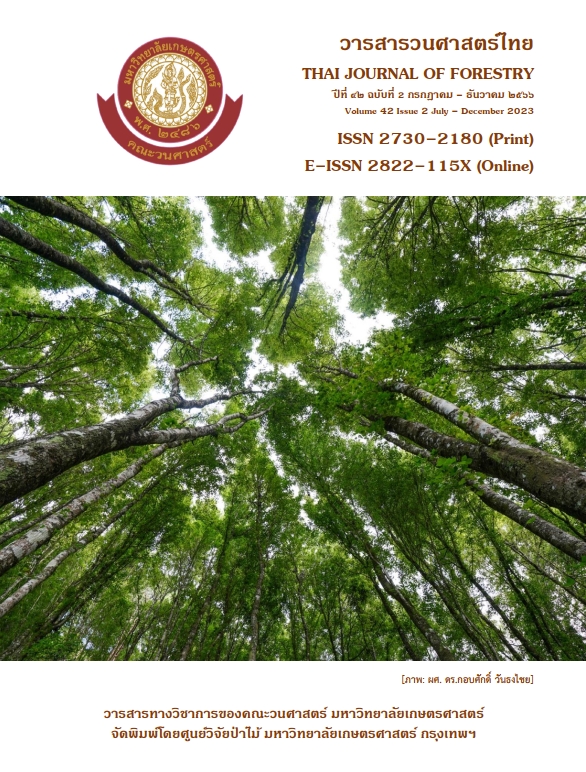การกลับคืนของแมลงผิวดินภายหลังการเผา บริเวณอุทยานแห่งชาติศรีน่าน จังหวัดน่าน
Main Article Content
บทคัดย่อ
การกลับคืนของแมลงผิวดินภายหลังการถูกไฟเผา ได้ศึกษาในพื้นที่อุทยานแห่งชาติศรีน่าน จังหวัดน่าน ทำการเลือกพื้นที่ศึกษา 3 ประเภท คือ พื้นที่ป่าเบญจพรรณ พื้นที่ป่าเต็งรัง และพื้นที่เกษตร ตามระยะเวลาหลังการเผาที่แตกต่างกันได้แก่ ภายหลังเผา 1, 10, 30 และ 90 วัน ในพื้นที่ถูกไฟเผา และพื้นที่ไม่ถูกไฟเผาด้วยวิธีการวางกับดักหลุม ดำเนินการเก็บข้อมูลระหว่างเดือนกุมภาพันธ์ ถึงเดือน กรกฎาคม พ.ศ. 2565 ผลการศึกษาพบแมลงผิวดินทั้งหมด 127 ชนิด 39 วงศ์ 11 อันดับ ซึ่งแมลงในอันดับ Hymenoptera พบจำนวนชนิดและจำนวนตัวแมลงผิวดินมากที่สุด คิดเป็นร้อยละ 39.37และ 70.35 ของจำนวนที่พบทั้งหมดในพื้นที่ภายหลังการเผาพบชนิดแมลงผิวดินในพื้นที่ป่าเบญจพรรณมากที่สุด รองลงมาเป็นพื้นที่เกษตร และป่าเต็งรัง จำนวน 53, 48 และ 45 ชนิด ตามลำดับ โดยค่าดัชนีความหลากหลายทางชนิดในพื้นที่หลังเผาพบพื้นที่เกษตรมีค่ามากที่สุด รองลงมาเป็นพื้นที่ป่าเต็งรังและพื้นที่ป่าเบญจพรรณมีค่าเท่ากับ 3.13, 3.00 และ 2.94 ตามลำดับ ค่าดัชนีความสม่ำเสมอมีค่าอยู่ในช่วง 0.45–0.70 ส่วนค่าดัชนีความคล้ายคลึงพบว่าพื้นที่ป่าเต็งรังควบคุมไฟมีค่าความคล้ายคลึงกับพื้นที่ป่าเต็งรังหลังถูกไฟเผามากที่สุด คือร้อยละ 0.70 เมื่อวิเคราะห์สหสัมพันธ์ในพื้นที่แต่ละช่วงเวลาภายหลังเผา โดยใช้ Pearson correlation ระหว่างจำนวนชนิด จำนวนตัว และอุณหภูมิดินพบว่าจำนวนตัวของแมลงผิวดินมีความสัมพันธ์กับอุณหภูมิดินอย่างมีนัยสำคัญทางสถิติ (p<0.01) แสดงให้เห็นว่าอุณหภูมิดินในแต่ละช่วงเวลาภายหลังการเผามีผลต่อการกลับคืนของแมลงผิวดิน
Downloads
Article Details

อนุญาตภายใต้เงื่อนไข Creative Commons Attribution-NonCommercial-NoDerivatives 4.0 International License.
ข้าพเจ้าและผู้เขียนร่วม (ถ้ามี) ขอรับรองว่า ต้นฉบับที่เสนอมานี้ยังไม่เคยได้รับการตีพิมพ์และไม่ได้อยู่ในระหว่างกระบวนการพิจารณาตีพิมพ์ลงในวารสารหรือสิ่งตีพิมพ์อื่นใด ข้าพเจ้าและผู้เขียนร่วม (ถ้ามี) ยอมรับหลักเกณฑ์และเงื่อนไขการพิจารณาต้นฉบับ ทั้งยินยอมให้กองบรรณาธิการมีสิทธิ์พิจารณาและตรวจแก้ต้นฉบับได้ตามที่เห็นสมควร พร้อมนี้ขอมอบลิขสิทธิ์ผลงานที่ได้รับการตีพิมพ์ให้แก่วารสารวนศาสตร์ คณะวนศาสตร์ มหาวิทยาลัยเกษตรศาสตร์ กรณีมีการฟ้องร้องเรื่องการละเมิดลิขสิทธิ์เกี่ยวกับภาพ กราฟ ข้อความส่วนใดส่วนหนึ่ง หรือ ข้อคิดเห็นที่ปรากฏในผลงาน ให้เป็นความรับผิดชอบของข้าพเจ้าและผู้เขียนร่วม (ถ้ามี) แต่เพียงฝ่ายเดียว และหากข้าพเจ้าและผู้เขียนร่วม (ถ้ามี) ประสงค์ถอนบทความในระหว่างกระบวนการพิจารณาของทางวารสาร ข้าพเจ้าและผู้เขียนร่วม (ถ้ามี) ยินดีรับผิดชอบค่าใช้จ่ายทั้งหมดที่เกิดขึ้นในกระบวนการพิจารณาบทความนั้น”
เอกสารอ้างอิง
Bourmas, C., 2005. Species Diversity of Ants at Huay Khayeng, Thong Pha Phum District, Kanchanaburi Province. M.S. Thesis, Kasetsart University, Bangkok, Thailand. (in Thai)
Hosoishi, S., Tasen, W., Park, S., Ngoc, A., Kuboki, Y., Ogata, K. 2014. Annual fire resilience of ground-dwelling ant communities in Hiraodai Karst Plateau grassland in Japan. Entomological Science, 18(2): 254–261. doi.org/10.1111/ens.12117
Krebs, C.J. 1972. Ecology: The Experimental Analysis of Distribution and Abundance. Harper and Row Publishers, New York, USA.
Ludwing, J.A., Reynolds, J.F. 1988. Statistical Ecology. John Wiley and Sons, New York, USA.
Meenwang, N., Payakka, A., Prommi, T. 2012. An application of aquatic insects as bioindicators of water quality in Mae Tao creek, Mae Sot district, Tak province. Journal of Food Health and Bioenvironmental Science, 5(2): 113-123. (in Thai)
Phongam, J., Pitaktunsakul P., Soompee T. 2015. Species diversity of ants in the bamboo forest, Khuean Srinagarindra National Park Kanchanaburi province. Journal of Kanchanaburi Rajabhat University, 4(1): 82-90. (in Thai)
Santisuk, T. 2012. Forest of Thailand., 3rd ed. Forest and Plant Conservation Research Office, Department of National Parks, Wildlife and Plant Conservation. Bangkok, Thailand. (in Thai)
Seekhiew, A., Tasen, W., Teejuntuk, S. 2020. Ground dwelling insect community in limestone mining rehabilitation area, Saraburi province. Thai Journal of Forestry, 39 (1): 1-10. (in Thai)
Sørensen, F.B 1984. Physical measurement as risk indicators for low-back trouble over a one-year period. Journal of Spinal Disorders and Techniques, 9(2): 106-19. DOI: 10.1097/00007632-198403000-00002
Suwanwaree, P., Phayungwiwatthanakoon, C. 2015. Impacts of Forest Fire on the Forest Fertility and Air Qfuality in Chiang Mai Province. Suranaree University of Technology. Nakhon Ratchasima, Thailand. (in Thai)
Thompson, H., Lesser, M., Myers, L., Mihuc, T. 2022. Insect community response following wildfire in an eastern north American pine Barrens. Forest, 13(1): 66. doi.org/10.3390/f13010066
Udomsin, A. 1996. Effects of Forest Fire on Soil Arthropods at Phu Kradung National Park, Changwat Loei. M.S. Thesis. Kasetsart University. Bangkok, Thailand. (in Thai)
Wanthongchai, K. 2011. Fire Ecology in Pine-related Forests and its effects on Vegetation and Nutrient Dynamics at Phu Koom Khaw, Nam Nao National Park. Thailand Science Research and Innovation, Bangkok, Thailand. (in Thai)
Wilson, E.O. 2000. Ants Standard Methods for Measuring and Monitoring Biodiversity. Smithsonian Institution Press. Washington, USA.
Wiwatwittaya, D. 1991. The Effects of Forest Fire on Soil Insects at Doi Angkhang, Changwat Chiang Mai. M.S. Thesis. Kasetsart University. Bangkok, Thailand. (in Thai)
Wiwatwittaya, D. 1996. Diversity of soil insects at hill evergreen forest Doi Angkhang, Chiang Mai province. Thai Journal of Forestry, 15: 132-137. (in Thai)


